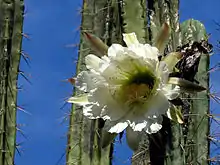Echinopsis peruviana
Echinopsis peruviana (syn. Trichocereus peruvianus), the Peruvian torch cactus, is a fast-growing columnar cactus native to the western slope of the Andes in Peru, between about 2,000–3,000 m (6,600–9,800 ft) above sea level.
| Peruvian torch cactus | |
|---|---|
 | |
| Scientific classification | |
| Kingdom: | Plantae |
| Clade: | Tracheophytes |
| Clade: | Angiosperms |
| Clade: | Eudicots |
| Order: | Caryophyllales |
| Family: | Cactaceae |
| Subfamily: | Cactoideae |
| Genus: | Echinopsis |
| Species: | E. peruviana |
| Binomial name | |
| Echinopsis peruviana (Britton & Rose) Friedrich & G.D.Rowley | |
| Synonyms | |
|
Trichocereus peruvianus Britton & Rose | |
Description
The plant is bluish-green in color, with frosted stems, and 6-9 broadly rounded ribs; it has large, white flowers. It can grow up to 3–6 m (9.8–19.7 ft) tall, with stems up to 8–18 cm (3.1–7.1 in) in diameter; it is fully erect to begin with, but later possibly arching over, or even becoming prostrate. Groups of 6-8 honey-colored to brown rigid spines, up to 4 cm (1.6 in) in length, with most about 1 cm (0.39 in), are located at the nodes, which are evenly spaced along the ribs, up to approximately 2.5 cm (0.98 in) apart.
Taxonomy
Varieties
Some varieties, with scientifically invalid names, of Echinopsis peruviana are:
- var. ancash (KK1688), San Marcos, Ancash, northwest Peru.
- var. ayacuchensis (KK2151), southwestern Peru.
- var. cuzcoensis (KK340), Huachac, Cuzco, southeastern Peru.
- var. (H14192), Huntington, USA.
- var. huancabamba, Piura, northwest Peru.
- var. huancavelica (KK242a), west central Peru.
- var. huancayo (KK338), west central Peru.
- var. huaraz (KK2152), Ancash, northwestern Peru.

- var. matucana (KK242) Lima, central west Peru.
- var. puquiensis (KK1689), Puquio, Apurímac Region, southwestern Peru.
- var. Rio Lurin (KK2147), Rio Rimac, Lima, west central Peru.
- var. tarmensis (KK2148), Tarma, Junín, west central Peru.
- var. trujilloensis, Trujillo, La Libertad, northwestern Peru.
Mescaline content
Echinopsis peruviana is one of a number of Echinopsis species native to the Andes that have been reported to contain the psychoactive alkaloid mescaline. Others include E. pachanoi, E. lageniformis, E. scopulicola, E. santaensis and E. puquiensis. All those columnar species thought to be psychoactive have been called "San Pedro" in Spanish. Reported concentrations of mescaline vary widely, with causes suggested to include: taxonomic uncertainty leading to difficulties in identification; genetic differences between species and within populations; environmental factors, such as temperature and water availability, affecting plants during growth; and variations in laboratory techniques.[2]
Some studies have reported no mescaline content in wild-harvested Peruvian specimens of E. peruviana,[3] and in plants grown in Europe.[4] In those studies that have compared different species and cultivars, when mescaline has been found, it has been at very much lower concentrations than in the highest yielding forms of other species; for example 0.24% of dry weight for E. peruviana KK242 compared to 4.7% for a strain of E. pachanoi on sale in traditional Peruvian shamans' markets, a factor of almost 20 times less.[2]
Notes
- "Echinopsis peruviana ssp. puquiensis". www.desert-tropicals.com. Retrieved 2008-02-23.
- Ogunbodede, Olabode; McCombs, Douglas; Trout, Keeper; Daley, Paul & Terry, Martin (2010). "New mescaline concentrations from 14 taxa/cultivars of Echinopsis spp. (Cactaceae) ("San Pedro") and their relevance to shamanic practice". Journal of Ethnopharmacology. 131 (2): 356–362. doi:10.1016/j.jep.2010.07.021. PMID 20637277.
- Djerassi, Carl; Liu, L.H.; Farkas, E.; Lippman, A.E.; Lemin, A.J.; Geller, L.E.; McDonald, R.N. & Taylor, B.J. (1955). "Terpenoids. XI.1 Investigation of Nine Cactus Species. Isolation of Two New Triterpenes, Stellatogenin and Machaeric Acid". Journal of the American Chemical Society. 77 (5): 1200–1203. doi:10.1021/ja01610a033.
- Agurell, S. (1969), "Cactaceae alkaloids. I", Lloydia, 32 (2): 206–216, PMID 5812246
References
- James D. Mauseth, Roberto Kiesling, Cactus and Succulent Journal (US) 70 (1): 32-39
- Michael S. Smith, The Narcotic and Hallucinogenic Cacti of the New World
- William Rafti, "KK242 Notes and photos" ASIN: B001EHF2BU ISBN 0-9720525-5-0 Library of Congress Number: 2008902776
External links
| Wikispecies has information related to Echinopsis peruviana. |
 Media related to Echinopsis peruviana at Wikimedia Commons
Media related to Echinopsis peruviana at Wikimedia Commons- Echinopsis peruviana (Desert Tropicals)